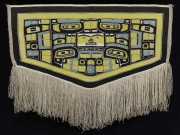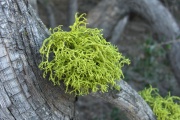Difference between revisions of "Vulpinic acid"
Jump to navigation
Jump to search
(Created page with "== Description == (Headers are set off with the double equal signs on each side. The description is a paragraph that should contain the following: material classification, la...") |
|||
| (20 intermediate revisions by the same user not shown) | |||
| Line 1: | Line 1: | ||
| + | [[File:Chilkat blanket.jpg|thumb|Chilkat Dancing Blanket<br>MFA# 2008.650]] | ||
== Description == | == Description == | ||
| − | ( | + | A natural yellow dye extracted from wolf lichen (''Letharia vulpina''). Vulpinic acid (C19H14O5) is a methyl ester derivative of pulvinic acid that was first isolated in 1925. The bright yellow dye has been used by Northwest Coast First Peoples for dyeing porcupine quills and wool. It was identified by MALDI-TOF mass spectrometry in yellow wool in the MFA's ''Chilkat Dancing Blanket'' (#2008.650) |
| − | + | [[File:1280px-Letharia vulpina JHollinger.jpg|thumb|Wolf lichen (''Letharia vulpina'')]] | |
| − | [[File: | + | == Synonyms and Related Terms == |
| + | |||
| + | ''Letharia vulpinia''; vulpic acid; benzeneacetic acid, alpha-(3-hydroxy-5-oxo-4-phenyl-2(5H)-furanylidene)-, methyl ester, (E)- (9CI); methyl (2E)-2-(3-hydroxy-5-oxo-4-phenylfuran-2-ylidene)-2-phenylacetate; Methylpulvinsaure; | ||
| + | |||
| + | ==Risks== | ||
| + | * Vulpinic acid is acutely toxic by ingestion and may be absorbed through the skin. | ||
| + | * Cayman Chemical: [https://cdn.caymanchem.com/cdn/msds/21685m.pdf SDS] | ||
| + | |||
| + | ==Physical and Chemical Properties== | ||
| + | {| class="wikitable" | ||
| + | |- | ||
| + | ! scope="row"| Composition | ||
| + | | C19H14O5 | ||
| + | |- | ||
| + | ! scope="row"| CAS | ||
| + | | 521-52-8 | ||
| + | |- | ||
| + | ! scope="row"| Molecular Weight | ||
| + | | mol. wt. = 322.32 g·mol−1 | ||
| + | |- | ||
| + | ! scope="row"| Solubility | ||
| + | | water, hexane, acetone | ||
| + | |} | ||
| − | |||
== Sources Checked for Data in Record == | == Sources Checked for Data in Record == | ||
| − | + | * George Thornton Emmons, ''The Tlingit Indians'', Anthropological Papers of the American Museum of Natural History, 1991. | |
| − | + | * Leonard Soltzberg, internal report | |
| − | * | + | * Pub Chem Open Chemistry Database, https://pubchem.ncbi.nlm.nih.gov/compound/vulpinic_acid#section=Top |
| − | * | ||
| − | |||
[[Category:Materials database]] | [[Category:Materials database]] | ||
Latest revision as of 10:45, 26 June 2022
Description
A natural yellow dye extracted from wolf lichen (Letharia vulpina). Vulpinic acid (C19H14O5) is a methyl ester derivative of pulvinic acid that was first isolated in 1925. The bright yellow dye has been used by Northwest Coast First Peoples for dyeing porcupine quills and wool. It was identified by MALDI-TOF mass spectrometry in yellow wool in the MFA's Chilkat Dancing Blanket (#2008.650)
Synonyms and Related Terms
Letharia vulpinia; vulpic acid; benzeneacetic acid, alpha-(3-hydroxy-5-oxo-4-phenyl-2(5H)-furanylidene)-, methyl ester, (E)- (9CI); methyl (2E)-2-(3-hydroxy-5-oxo-4-phenylfuran-2-ylidene)-2-phenylacetate; Methylpulvinsaure;
Risks
- Vulpinic acid is acutely toxic by ingestion and may be absorbed through the skin.
- Cayman Chemical: SDS
Physical and Chemical Properties
| Composition | C19H14O5 |
|---|---|
| CAS | 521-52-8 |
| Molecular Weight | mol. wt. = 322.32 g·mol−1 |
| Solubility | water, hexane, acetone |
Sources Checked for Data in Record
- George Thornton Emmons, The Tlingit Indians, Anthropological Papers of the American Museum of Natural History, 1991.
- Leonard Soltzberg, internal report
- Pub Chem Open Chemistry Database, https://pubchem.ncbi.nlm.nih.gov/compound/vulpinic_acid#section=Top

